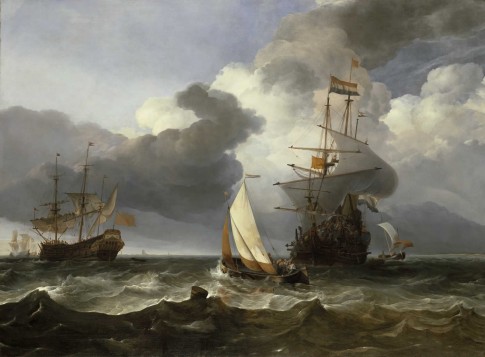By Hendrik-Jacobsz Dubbels
A dramatic portrayal of two Dutch East Indiamen who may have returned from a journey overseas. The ship on the left, in distant port-quarter view, has a scene painted on her stern depicting a pavilion with trees, possibly palm trees and thus a reference to her exotic trade associations. Men are portrayed in the rigging, working on the sails. In the centre foreground, a smalschip sails into wind and six men can be seen in her stern. A smalschip, meaning narrow ship, took its name from its ability to negotiate locks on inland waterways. One of the men gestures towards the ship on the far right, seen in port-bow view with a carved figurehead of a lion. The deck is laden with men busy on various tasks as it prepares to anchor. The two ships are flying Dutch flags and a plain red jack. In the far distance, a landscape can be seen on either side of the picture. To the far left, this includes a skyline of church towers, and to the right, the curved shape of dunes, suggesting this is an estuary scene or a channel between islands on the Dutch coast. Strong contrasts of light and dark dominate both sea and sky, and the striking formation of the clouds dominates the top-half of the image. The artist has signed his name on the buoy in the centre foreground.
Dubbels was an Amsterdam painter working chiefly within the tradition established by his master, Simon de Vlieger, and with other marine artists. He is thought to have worked in the studio of the van de Veldes, before they moved to London, and the Dutch marine artist Ludolf Bakhuysen was his pupil.
